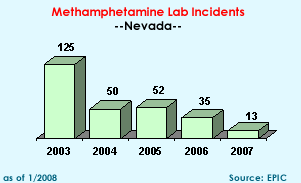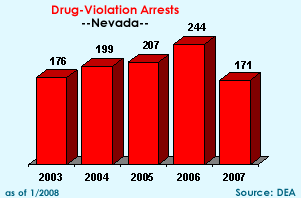|
DEA
Offices & Telephone Nos.
Las Vegas—702-759-8000
Reno—775-784-5617 |
State Facts
Population: 2,414,807
State Prison Population: 11,365
Probation Population: 12,521
Violent Crime Rate
National Ranking: 8 |
2007
Federal Drug Seizures
Cocaine: 52.2 kgs.
Heroin: 0.1 kgs.
Methamphetamine: 27.3 kgs./950 du
Marijuana: 43.5 kgs.
Hashish: 0.0 kgs.
MDMA: 0.0 kgs./20,875 du
Meth
Lab Incidents: 13
(DEA, state, and local) |
Drug
Situation: Methamphetamine, specifically crystal methamphetamine
produced in Mexico and imported into the state, has become the principal
drug of concern in Nevada.
In
addition, cocaine, particularly crack cocaine, is a significant problem
in the urban areas of the state. Due
to its close proximity to California and its porous border, Nevada often
serves
as a transshipment
point for various drugs
to the central and eastern sections of the United States. There has also
been a significant increase in deaths (total of 107 for all of CY06)
attributed to diverted
pharmaceuticals.
 Cocaine:
Cocaine HCl is moderately available in northern Nevada and readily available
throughout southern Nevada. Cocaine HCl is transported into Nevada
primarily
from California via ground transportation. Southern Nevada, specifically
Las Vegas, serves as a transshipment point for cocaine HCl with
distribution
points across the nation. Crack cocaine is readily available in the urban
areas of Nevada. African American street gangs predominantly control
the
distribution market for crack cocaine and base their operations in inexpensive
motel rooms and apartments located in impoverished areas throughout
Nevada's
larger cities. Cocaine:
Cocaine HCl is moderately available in northern Nevada and readily available
throughout southern Nevada. Cocaine HCl is transported into Nevada
primarily
from California via ground transportation. Southern Nevada, specifically
Las Vegas, serves as a transshipment point for cocaine HCl with
distribution
points across the nation. Crack cocaine is readily available in the urban
areas of Nevada. African American street gangs predominantly control
the
distribution market for crack cocaine and base their operations in inexpensive
motel rooms and apartments located in impoverished areas throughout
Nevada's
larger cities.
 Heroin:
Mexican black tar heroin remains the most prevalent heroin available
in Nevada. There has been an increase of Mexican black tar heroin
within the Clark County portion of the Nevada HIDTA controlled by
Mexican nationals. Mexican poly-drug trafficking organizations control
the heroin
trafficking in the state. These trafficking organizations continue to
recruit Mexican nationals to live in the urban areas of Nevada to
distribute
heroin for the organization. User amounts of low purity black tar heroin
remain readily available from these low-level suppliers and are
most often
distributed in open air markets. Mexican Brown Heroin is moderately available
in Clark County and its distribution is also controlled by Mexican
Nationals. Heroin:
Mexican black tar heroin remains the most prevalent heroin available
in Nevada. There has been an increase of Mexican black tar heroin
within the Clark County portion of the Nevada HIDTA controlled by
Mexican nationals. Mexican poly-drug trafficking organizations control
the heroin
trafficking in the state. These trafficking organizations continue to
recruit Mexican nationals to live in the urban areas of Nevada to
distribute
heroin for the organization. User amounts of low purity black tar heroin
remain readily available from these low-level suppliers and are
most often
distributed in open air markets. Mexican Brown Heroin is moderately available
in Clark County and its distribution is also controlled by Mexican
Nationals.
  Methamphetamine: Meth
is the most frequently encountered drug in Nevada and remains available
in both personal use and distribution quantities. Nevada is both a
point of importation and a transshipment location for methamphetamine.
The manufacture of methamphetamine in Nevada occurs on a limited basis.
The
meth imported into the state is produced primarily in "super
labs"
(producing 10 pounds or more in a 24-hour period) by ethnic Mexican drug
trafficking organizations operating in Mexico and California. Meth is
transported to Nevada primarily via ground transportation. Organized
Mexican poly-drug trafficking groups monopolize the large-scale meth
trade in
Nevada. Distributor levels of imported methamphetamine average in pound
quantities or greater. Mexican produced crystal methamphetamine is the
most readily available in Nevada and purity levels have decreased
from the 90 percent to 99 percent range to the 50% range. Local meth
manufacturing
continues to decrease small quantities, usually
under one ounce per cook. Laboratories seized recently utilized
the
pseudoephedrine, red phosphorus, and iodine method to manufacture methamphetamine. Methamphetamine: Meth
is the most frequently encountered drug in Nevada and remains available
in both personal use and distribution quantities. Nevada is both a
point of importation and a transshipment location for methamphetamine.
The manufacture of methamphetamine in Nevada occurs on a limited basis.
The
meth imported into the state is produced primarily in "super
labs"
(producing 10 pounds or more in a 24-hour period) by ethnic Mexican drug
trafficking organizations operating in Mexico and California. Meth is
transported to Nevada primarily via ground transportation. Organized
Mexican poly-drug trafficking groups monopolize the large-scale meth
trade in
Nevada. Distributor levels of imported methamphetamine average in pound
quantities or greater. Mexican produced crystal methamphetamine is the
most readily available in Nevada and purity levels have decreased
from the 90 percent to 99 percent range to the 50% range. Local meth
manufacturing
continues to decrease small quantities, usually
under one ounce per cook. Laboratories seized recently utilized
the
pseudoephedrine, red phosphorus, and iodine method to manufacture methamphetamine.
 Club
Drugs: The availability of "club drugs" in
Nevada ranges from sporadic in the northern urban areas to
readily available
in cities located in the southern section ofthe state, particularly Las
Vegas. Club drugs, specifically MDMA, GHB, and LSD,are trafficked
and
abused in local nightclubs, adult entertainment clubs, and at raves.
The trafficking of these drugs ranges from hand-to-hand sales
within
clubs
or raves to larger sales between locals and out-of-town distributors.
Las Vegas serves as a point of importation and a transshipment
area for MDMA.
Most MDMA that passes through or is destined for Las Vegas continues
to come primarily from southern California and New York. Limited
reporting shows Asian drug trafficking organizations are responsible
for a significant amount of MDMA distribution throughout Nevada.
MDMA destined for Las Vegas comes primarily from southern California
and the San Francisco area. Club
Drugs: The availability of "club drugs" in
Nevada ranges from sporadic in the northern urban areas to
readily available
in cities located in the southern section ofthe state, particularly Las
Vegas. Club drugs, specifically MDMA, GHB, and LSD,are trafficked
and
abused in local nightclubs, adult entertainment clubs, and at raves.
The trafficking of these drugs ranges from hand-to-hand sales
within
clubs
or raves to larger sales between locals and out-of-town distributors.
Las Vegas serves as a point of importation and a transshipment
area for MDMA.
Most MDMA that passes through or is destined for Las Vegas continues
to come primarily from southern California and New York. Limited
reporting shows Asian drug trafficking organizations are responsible
for a significant amount of MDMA distribution throughout Nevada.
MDMA destined for Las Vegas comes primarily from southern California
and the San Francisco area.
 Marijuana:
Domestically cultivated and Mexican-grown marijuana remains readily available
in Nevada. Mexican poly-drug trafficking organizations are still
the primary
source of marijuana smuggled into the area, primarily from California
via ground transport. There has been an increased prevalence of
indoor
marijuana cultivation in the Las Vegas area during the past year. Growers
are using elaborate hydroponic equipment to cultivate high-grade
marijuana.
In June 2001, Assembly Bill 453 was signed into
law and made Nevada the ninth state in the U.S. where patients can
use
marijuana for medicinal purposes. In addition, the new state law, which
went into effect October 1, 2001, decriminalizes possession of small
amounts
(ounce quantity or less) of marijuana, which was previously a state
felony. Marijuana:
Domestically cultivated and Mexican-grown marijuana remains readily available
in Nevada. Mexican poly-drug trafficking organizations are still
the primary
source of marijuana smuggled into the area, primarily from California
via ground transport. There has been an increased prevalence of
indoor
marijuana cultivation in the Las Vegas area during the past year. Growers
are using elaborate hydroponic equipment to cultivate high-grade
marijuana.
In June 2001, Assembly Bill 453 was signed into
law and made Nevada the ninth state in the U.S. where patients can
use
marijuana for medicinal purposes. In addition, the new state law, which
went into effect October 1, 2001, decriminalizes possession of small
amounts
(ounce quantity or less) of marijuana, which was previously a state
felony.
Pharmaceutical
Diversion: Current investigations
indicate that diversion of OxyContin® continues to be a problem
in Nevada. Primary methods of diversion being reported are illegal
sale and distribution by health care professionals and workers,
and “doctor shopping” (going to a number of doctors
to obtain prescriptions for a controlled pharmaceutical). Hydrocodone
products, methadone, Actiq® (fentanyl) and benzodiazepines
(such as Xanax® and Valium®) were also identified as being
among the most commonly abused and diverted pharmaceuticals in
Nevada. The
pharmaceutical controlled substances of choice in Nevada include
hydrocodone, Xanax®, codeine, diazepam, Ketamine, Lortab®,
and oxycodone. Drug combinations which are abused in the state
of Nevada are Lortab® and Soma® and Lortab® and benzodiazepines.
Non-controlled substances which appear to be abused in Nevada are
Soma® and Ultram®. The primary method of diversion in Nevada
is the illegal purchase of controlled substances via Internet pharmacies.
In addition, prescription fraud is on the rise in both the Las
Vegas and Reno areas. Pseudoephedrine sales are reported down since
a new law adding pseudoephedrine to the Nevada Controlled Substance
list passed in December 2001.
  DEA
Mobile Enforcement Teams: This cooperative program with state and local law enforcement counterparts was conceived in 1995 in response to the overwhelming problem of drug-related violent crime in towns and cities across the nation. Since the inception of the MET Program, 473 deployments have been completed nationwide, resulting in 19,643 arrests. There have been three MET deployments in the State of Nevada since the inception of the program, in Reno, Carson City, and Las Vegas. DEA
Mobile Enforcement Teams: This cooperative program with state and local law enforcement counterparts was conceived in 1995 in response to the overwhelming problem of drug-related violent crime in towns and cities across the nation. Since the inception of the MET Program, 473 deployments have been completed nationwide, resulting in 19,643 arrests. There have been three MET deployments in the State of Nevada since the inception of the program, in Reno, Carson City, and Las Vegas.
Special
Topics: The
Clark County High Intensity Drug Trafficking Area (HIDTA) was established
by the Office of National Drug Control Policy in 2001 to combat the influx
of drug trafficking in southern Nevada. In order to alleviate the
meth
problem in southern Nevada, a HIDTA initiative, the Southern Nevada Joint
Methamphetamine Task Force, was created to address domestic trafficking
organizations and career criminal enterprises which are involved in the
manufacture of methamphetamine and the transport and distribution
of meth
and precursor chemicals within and through the HIDTA area of operation.
The primary focus of this task force will be the dismantling
and federal
prosecution of such organized drug and precursor chemical trafficking
groups.
More information
about the Los Angeles Division Office.
Sources
Factsheet last updated: 1/2008
Click here for last year's factsheet >>
|

